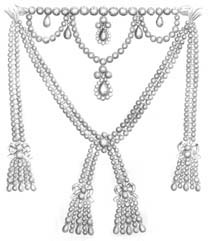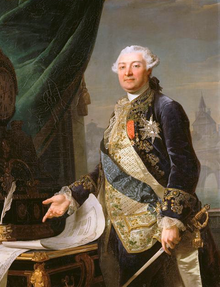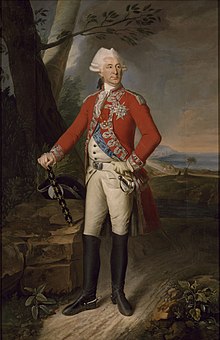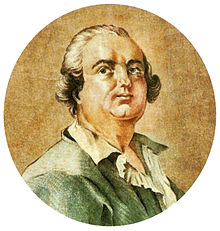Collar affair
The so-called collar affair ( French l'affaire du collier de la reine ; in German formerly known as collar story) was a fraud scandal at the French court in 1785 and 1786, in which Queen Marie Antoinette was also involved.
overview
Cardinal Louis de Rohan , ambassador to Vienna since 1772 , aroused the displeasure of Maria Theresa as a result of his luxurious and relaxed lifestyle . Therefore, in 1774, at their pressure, he was recalled from his post. Already out of favor at the French court, de Rohan wanted to win back the favor of the French royal couple at all costs. The cunning swindler Countess de La Motte ( Jeanne de Saint-Rémy ) supposedly wanted to help the gullible cardinal. She handed him forged letters from the Queen and loaned him money on her behalf. At that time, two jewelers had offered Marie Antoinette a precious diamond necklace in vain; the king had refused a purchase because of the high price. Now the countess persuaded the cardinal that he could finally win back the queen's heart if he helped her acquire the piece of jewelry. After de Rohan had vouched for the purchase price and received the necklace from the jewelers, he handed it over to the countess. However, this was not given to the queen as promised, but to her husband, who broke out the stones and sold them.
course
The collar
The Parisian jewelers Charles Auguste Boehmer and Paul Bassenge had collected diamonds of exceptional size and clarity for a number of years for a necklace worth 1.8 million livres , which they first gave to Madame Dubarry , the mistress of Louis XV. hoped to sell. After the king's death, the unusual piece of jewelery became known all over Europe, but everywhere people shied away from the price.
In 1778 Louis XVI. proposed to the queen to give her the necklace, but she declined because of the high price. After the jewelers had tried in vain to sell the necklace outside of France, they approached the king again in 1781 after the birth of the dauphin Louis-Joseph-Xavier-François (1781–1789), who again refused after some hesitation.


The sale
At the end of 1784, Böhmer and Bassenge started looking for an intermediary who could induce the king or queen to buy. A certain Sieur Achet told them that his son-in-law, the advocate Laporte, knew of a Countess La Motte who was familiar with the queen. The jewelers visited the lady, who promised to speak to the queen about the matter. Three weeks later, on January 21, 1785, the Countess assured the jewelers that the Queen would own the necklace. She would commission a very high-ranking gentleman to come to them with the Queen's instructions.
On January 24, 1785, Madame de La Motte, accompanied by her husband, appeared at the jewelers and announced the imminent visit of the Lord. The announced visit arrived a little later. It was Cardinal Louis de Rohan . The cardinal negotiated the price and got it reduced to 1.6 million livres.
On January 29th, Rohan called the jewelers over. He read them a paper that contained all the terms of the purchase. The purchase price of 1.6 million was to be paid within two years in four installments of 400,000 livres every six months; the first installment was due on August 1st. The two jewelers signed the contract.
On February 1, the cardinal called the jewelers again and asked them to bring the necklace with them. He showed them the contract, which now also contained the signature "Marie Antoinette of France", and a document addressed to him by the Queen. At the same time, the cardinal revealed that he had advised the queen against buying it, but that her desire to own the necklace was stronger. Böhmer and Bassenge said goodbye, the collar stayed with Cardinal Rohan.
On July 10th, Rohan summoned the jewelers and told them that the Queen was asking for a discount of 200,000 livres. In addition, they would not receive 400,000 livres on August 1, as agreed, but 700,000 a few days later. The jewelers agreed. The cardinal then dictated a letter of thanks to the queen.
On July 12th, Böhmer brought the queen a shoulder jewelry and a pair of diamond earrings that the king had ordered for her on the occasion of the birth of their second son. He handed her the letter in which he expressed his joy that she wanted to wear the most beautiful diamond jewelry in the world. A few days later, Marie Antoinette's maid, Madame Jeanne Louise Henriette Campan , asked him what this letter was about, the Queen had nothing to do with it.
Rohan now urged the jewelers to speak to the Queen herself. When the jewelers had to testify later, they avoided any hint of a conversation with the queen. However, Abbé Georgel, the grand vicar and confidante of Cardinal Rohan, wrote in his memoir that this conversation actually took place and that the jewelers had told the queen everything they knew.
On July 31st the cardinal called the jewelers again. He informed them that the queen could not raise the full 700,000 livres, but that they would certainly get the full amount in early October. Then he gave them 30,000 livres out of his own pocket as compensation for the delay.
A few hours later, the banker Saint-James asked to speak to the Abbé Vermond, Marie Antoinette's advisor. He informed him that the cardinal intended to take out a loan of 700,000 livres on behalf of the Queen. In view of the size of the sum, he asked for precise and direct instructions.
On August 3rd, Madame de La Motte asked Bassenge to come to her. She complained that they wanted to spoil the cardinal, that he had found that the alleged document of the queen was false. The jewelers should immediately make an agreement to pay for the collar.
In their testimony, the jewelers said they had told the Queen everything on August 9th. Abbé Georgel, on the other hand, writes that this was one of the lies that the jewelers were forced into under pressure from Minister Breteuil to cover up the fact that he and the Queen had been up to date for at least a month.
Rohan's arrest

Marie Antoinette had a great dislike of Cardinal Louis de Rohan , former envoy in Vienna, from where he had been recalled in 1774 after arousing the displeasure of Empress Maria Theresa for his easy, superficial lifestyle. Marie Antoinette apparently considered him to be the informant who had told her mother Maria Theresa of her lavish lifestyle as the Dauphin's wife, for which she had to take rebukes several times. After his return to France, the cardinal endeavored to regain the favor of Marie Antoinette, who had meanwhile become queen. The motivation for this could have been the desire to obtain the position of prime minister.
Breteuil, on the other hand, saw a rival in Rohan. He convinced the Queen that Rohan had misused her name for a gigantic fraud. On August 14th, Breteuil submitted to the king, together with the jewelers' report, a dossier that presented Rohan's conduct as an insult to majesty .
On August 15, 1785 ( Assumption of Mary ), the entire court expected the king and queen around noon to go to the chapel, where Cardinal Rohan was to celebrate the solemn mass. Instead, the king called the cardinal over. After a short questioning in the presence of the queen, the latter confirmed that he had bought the collar for her. She herself gave him the job. After the cardinal was dismissed, after further deliberations he was arrested and taken to the Bastille . He was still able to have his correspondence with the supposed queen destroyed; it is not known whether this was done with the tacit consent of the officials, who in any case did not prevent it. Jeanne de La Motte was not arrested until August 18, after she destroyed her records. Her husband went to England.
The questioning of Rohan
The ministers Vergennes and Castries took over the official investigation of the case , since Rohan rejected Breteuil as biased and the king accepted this.
Rohan told them how, in September 1781, he met a penniless young girl who claimed she was descended from an illegitimate son of Henry II . In March 1784 she visited him again. After many adventures, Jeanne de Valois had married a self-proclaimed Comte de La Motte and lived on a small pension that the King granted her. She convinced the cardinal that she had been received by the queen and was enjoying her favor. Rohan decided to use them to regain the queen's benevolence. The Comtesse de La Motte assured the cardinal that she would intercede for him with the queen.
This was the beginning of an alleged correspondence between Rohan and the Queen in which the Comtesse replied forged replies to Rohan's letters to Marie Antoinette, which she asserted came from the Queen. The tone of the letters became very warm, and the cardinal, convinced that the Queen loved him, became passionate about her. He asked the Comtesse to arrange a secret conversation with the Queen, and in August 1784 there was a midnight meeting in a grove in the garden of Versailles between the Cardinal and a woman with a black hood, whom the Cardinal took to be the Queen. Rohan offered her a rose and she promised him that she would forget the past. Later, a certain Marie Lejay - who resembled Marie Antoinette - stated that she had been signed up for the role of the Queen in the comedy. After the affair became known, Marie Lejay immediately fled the country, initially to Belgium, where her trace was lost. She was never sued for the affair.
In any case, the Comtesse benefited from the cardinal's conviction. She asked for and received from him 50,000 livres and in November 100,000 livres, which were supposedly intended for the charitable works of the queen. With this money she was able to play a respectable role in society, and many believed in the authenticity of her close relationship with Marie Antoinette, of whom she publicly boasted.
On January 21, 1785, the Comtesse declared that the Queen wanted to buy the necklace, but wanted the purchase to be made through Cardinal Rohan. Rohan agreed and negotiated with the jewelers as requested. She kept the sales contract for two days and then brought it back with the signature "Marie Antoinette, Queen of France". On February 1, Rohan gave her the jewel in her apartment, where it was received by a man in black who he believed was a valet of the Queen.
At the beginning of June the Comtesse announced to the cardinal that the queen found her collar too expensive and wanted a price reduction of 200,000 livres. A few days later she showed him a letter in which the queen declared that she would pay 700,000 livres instead of 400,000 livres on August 1st a little later. In mid-July she told him that the Queen was unable to pay the promised 700,000 livres before October 1st. Madame de La Motte allayed Rohan's emerging suspicion by bringing him 30,000 livres as interest on the jewelers.
However, the queen never received the necklace. On the contrary, investigations during the later trial revealed that the Comte de La Motte had set out for London to sell diamonds made from the necklace.
process
Since Rohan had burned all the documents he believed to be the Queen's letters, he was unable to prove what he had said. After her arrest, Madame de La Motte contradicted his account on all points. She never spoke to the queen and Rohan never gave her the collar. He just hired her to sell a few diamonds to Jews.
On August 25, the King, Queen, Vergennes, Castries, Breteuil and Great Seal Keeper Armand Thomas Hue de Miromesnil discussed what should be done next. The Queen complained that the public had the impression that she had received a collar and had not paid for it. Eventually it was decided to give the cardinal the choice of having the matter resolved by the government or by public jurisdiction. Rohan hired the lawyer Guy Target to defend him and asked for a trial through the public judiciary.
The king, as chief judge, agreed to refer the case to the Paris Parliament , which he had convened again in 1774, and officially referred the matter to the Parliament on September 5. The case became the dominant talk of the day, with new rumors constantly emerging, especially since no official information was disclosed. The main focus of the discussions was initially the cardinal and the question of his guilt or innocence. Soon it was told how he had squandered huge sums of money on vicious amusements, and finally there was gossip in France and all of Europe about his bold and forbidden passion for the Queen. The view that the queen was a vicious woman who betrayed her husband became more and more popular. The sympathy for the cardinal, who was only the victim of his rival Breteuil, slowly grew.
Procurator General Joly de Fleury and Parliament President Étienne François d'Aligre initially followed the royal patent letters of September 6, which unequivocally demanded Rohan's conviction on the basis of insulting majesty. However, his relatives and lawyers fought tirelessly for his release. Their research revealed that Madame de La Motte probably had accomplices who were yet to be questioned. While the parliamentarians decided to see the cardinal as the main responsible fraudster and forger, his supporters tried to convict Madame de La Motte and her accomplices as masterminds of the affair.
Madame de La Motte, however, claimed that she had never boasted of an acquaintance with the Queen. She owed her fortune entirely to the generosity of the cardinal, and she had nothing to do with Rohan's supposed meeting with the queen. Instead, she accused the notorious impostor Alessandro Cagliostro of influencing the cardinal.
Gradually, the councilors began to have doubts about how things were going and they made further inquiries. They came to the conclusion that La Motte was the cardinal's mistress, who used his innocence for her own ends. As soon as she had the necklace, she had broken out the diamonds and her husband had taken it to London to sell the stones. On December 15, it was ordered that both Rohan and La Motte and Cagliostro should be arrested. The cardinal's relatives and friends accused the parliament of having bought it from the court. When the President of Parliament, the Procurator General and Councilor d'Amécourt met the Queen in the Tuileries and described the delicacy of the case, she refused to acknowledge Madame de La Motte's share in the affair and continued to see herself alone in the cardinal the guilty party. The police tried, however, to intervene from Vergennes to track down the accomplices and arrested both Marie Lejay and Cagliostro. The latter was in contact with Cardinal Rohan at the time of the affair, but it turned out that he was not involved in the affair. The clergy went to the king and the Pope intervened, but the cardinal remained imprisoned in the Bastille. Both he and Madame de La Motte were questioned frequently, but both stuck to their opposite versions of the story.
Marie Lejay admitted without further ado that she had met Monsieur de La Motte as a street girl and through him his wife. She was promised 15,000 livres for the nightly performance in the Park of Versailles, but she received only 4,000.
The accused's lawyers published reports on this and other events, which led to ridicule and abuse. Especially the night scene in the park of Versailles stimulated the fantasies tremendously, so that new alleged details about the meeting were revealed.
Shortly before the end of the trial, Reteaux de Villette appeared in court, which at the insistence of Rohan's relatives was apprehended in Geneva and taken to the Bastille in early April. He declared that he was Madame de La Motte's secretary and lover. Eventually he admitted to having written the letters sent to Rohan on behalf of the Queen and forging her signature on the contract.
Rohan was largely exonerated as regards the allegation of fraud and theft of the collar. That left only the crime of lese majesty, since Rohan had had the boldness to believe that the Queen had given him a rendezvous in the park of Versailles and asked him to buy a piece of jewelry on her behalf.
The taking of evidence was completed on May 29, and the Parliament met on May 30. General Procurator Joly de Fleury read the indictment. Madame de La Motte was to be flogged, marked with a V for “voleuse” (thief) on her shoulder and locked up in the Hôpital Salpêtrière for life . Monsieur La Motte in absentia and Villette were to be sentenced to life in the galley . The cardinal's boldness, on the other hand, was a crime which required sincere and solemn atonement, as befitted the royal majesty. He should solemnly ask the king and queen for forgiveness, be banished from the court and resign from the office of grand almsman.
Advocate General Séguier replied that Fleury's actions would cast a shame on all of the councilors. He made it clear that he believed that Fleury had been bribed by the court.
The sensational trial ended on May 31, 1786. The Comtesse de La Motte was condemned to a dust broom and branded and imprisoned according to the demands of the prosecution. Her husband was sentenced to life in the galley in absentia, and Villette was merely banished. Cagliostro and his wife were acquitted.
When they came to Rohan, councilors, beginning with the senior Boula de Montgofroy, repeatedly spoke up, demanding the cardinal's release. Thereupon President d'Aligre tried to soften the words of the procurator general. Then the parliament went into deliberation. Around midnight, after more than 17 hours, the judgment concerning the cardinal was finally passed.
Rohan was acquitted of exile from court with 26 votes to 22, but he had to pay the price of the collar to the jewelers Böhmer and Bassenge. He undertook to the same to pay out an annual sum of 300,000 livres from the income of the Abbey of Saint-Vaast until the debt was repaid in full.
Public opinion was violently aroused by this process. There were shouts of “Long live the Parliament!” And “Long live the innocent cardinal!” Thousands of people led Rohan to the Bastille, where he had to spend one last night.
Despite the acquittal, Louis XVI banished him. to the La Chaise-Dieu Abbey in Auvergne, which was subordinate to him, and deprived him of the dignity of a Grand Almosier of France and the ' cordon bleu '. This made it seem as if the cardinal was being condemned by the king after the parliament had acquitted him. When his health began to deteriorate, he was allowed to move to the Marmoutier Abbey in Touraine. Later he was allowed to return to his diocese.
Aftermath and literary processing
Many historians believe that Marie Antoinette was not guilty of misconduct on the matter and that Rohan was an innocent careless man whom the de La Mottes deceived for their own ends. Important sources for this assumption are the memoirs of Marie Antoinette's chambermaid, Madame Jeanne Louise Henriette Campan , and the grand vicar and confidante of the cardinal, Abbé Georgel. Both portray their superiors as innocent victims. The opponents of this representation, however, doubt precisely this ignorance.
The people, on the other hand, insisted that the Queen had used the Comtesse as a tool to satisfy her hatred of Cardinal de Rohan. The escape of Jeanne de La Motte from the Salpétrière, in which the people believed the court to be involved, reinforced this assumption and contributed to discrediting Marie Antoinette. After she had fled abroad, she published her memoirs in England in May 1789, in which she made serious accusations against the Queen. Contrary to what she said at the trial, she now presented herself as a close friend of the Queen, who helped her to ruin the cardinal. In 1858 the memoirs of her husband Marc Antoine Nicolas de La Motte were published.
The first literary processing of the affair was provided by Johann Wolfgang von Goethe in his comedy Der Groß-Cophta in 1791 . Alexandre Dumas the Elder wrote the novel The Queen's Necklace in 1848 . The 1942 novel Cardinal and Queen, Marie Antoinette's Collar Affair by Liesbet Dill is based on the memoirs of the Countess de La Motte.
literature
Non-fiction books :
- Thomas Carlyle : The French Revolution. A history . OUP, Oxford 1989, ISBN 0-19-281843-0 .
- Benedetta Craveri: Marie Antoinette and the collar affair. Berenberg Verlag , Berlin 2015, ISBN 978-3-937834-85-6 .
- Alexander Lernet-Holenia : The Queen's Collar . With contemporary art print images. Zsolnay, Hamburg / Vienna 1962, DNB 453006671 .
- Évelyne Lever: Marie Antoinette. A biography. Weltbild, Augsburg 1995, ISBN 3-89350-948-8 .
- Helmut Mathy : The collar affair. Cardinal Rohan and the Elector of Mainz. (= Aurea Moguntia . Volume 3). Von Zabern, Mainz 1989, ISBN 3-8053-1093-5 .
- Konrad Rahe: Cagliostro and Christ. On the biblical allusions in Goethe's comedy Der "Groß-Cophta" . Kovač, Hamburg 1994, ISBN 3-86064-194-8 (with an introductory description of the collar affair).
- Jeanne de Saint-Rémy : Justification of the Countess of Valois de La Motte . Andreae, Frankfurt am Main 1790.
- Stefan Zweig : Marie Antoinette. Portrait of a middle character; Novel . Fischer, Frankfurt am Main 2005, ISBN 3-596-50930-0 . [1]
Fiction :
- Dirk Böttger: The lilies are starting to wither. Novel . Droemer Knaur, Munich 2002, ISBN 3-426-63111-3 .
- Alexandre Dumas the Elder : The Queen's Necklace . Magnus, Essen 1987, ISBN 3-88400-265-1 .
- Elisabeth Hand: The collar affair. Heyne, Munich 2003, ISBN 3-453-21061-1 (The novel is based on the screenplay by John Sweet).
- Antal Szerb : The Queen's Collar . dtv, Munich 2005, ISBN 3-423-13365-1 .
- Michael Schneider : The Secret of Cagliostro . KiWi-Taschenbuch, Cologne 2007, p. 573 ff., ISBN 978-3-462-04024-1 .
Stage processing :
- Nick Edmund (music), Gerhard Metzner (text): The queen's collar. Operetta in three acts . Alkor Edition, Kassel 1959.
- Arno Nadel : Cagliostro and the history of the collar. Play in five acts . Stössinger, Berlin 1926 (1st edition 1913).
Web links
- The necklace story from Die Gartenlaube (1858) , Issue 15, pp. 209–212 by LK
See also
- The Queen's Collar (novel)
- The Queen's Necklace (2001) (film)
Individual evidence
- ↑ Conversations Lexicon . Concise concise dictionary for the subjects arising from the sciences and arts in social entertainment with constant consideration of the events of the older and more recent times. 1st edition. Kunst- und Industriecomptoir, Amsterdam 1809 ( zeno.org [accessed on 23 August 2021] encyclopedia entry “The history of the collar”).
- ↑ Collar story . In: Herders Conversations-Lexikon . Volume 3, Freiburg im Breisgau 1856, p. 212 .
- ↑ a b collar story. In: Meyers Großes Konversations-Lexikon . 6th edition. Volume 8, Bibliographisches Institut, Leipzig / Vienna 1907, p. 667 .
- ↑ Jörg Sieger: Cardinal in the shadow of the French Revolution. 4. The Prince-Bishop of Strasbourg and the 'Queen's Necklace'
- ^ Friedrich Weissensteiner, The Daughters of Maria Theresa, Verlag Kremayr & Scheriau, Vienna, 1994, ISBN 3-218-00591-4





